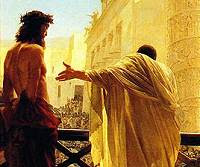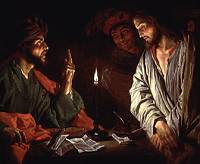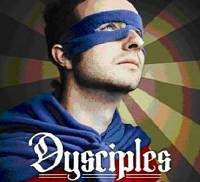Now we come to the greatest event of all time. John 20 records the resurrection of Yahshua the Messiah, the one who gave his life for us and could not be defeated by death.
 This is so unexpected and astonishing that the people who first saw him struggled with the idea. Let's look at their reactions.
This is so unexpected and astonishing that the people who first saw him struggled with the idea. Let's look at their reactions.Mary Magdalene - Mary was the first on the scene very early, it was still dark. She knew something had happened for she could see that the stone had been moved. She didn't go in but ran to Peter and John. Mary assumed that someone had taken the body.
By the time Peter and John left, Mary was in tears. She looked inside and saw two angels who asked her why she was crying. Her concern was for the body. Then she turned around, looked away from the tomb, and saw Yahshua who asked her the same question. She didn't recognise him until he spoke her name. He sent her to tell the disciples.
John - He was the first to look inside. He saw the linen strips. He didn't go in at first, but after Peter had done so he followed. John saw and believed.
Peter - Peter acted in character, he dashed right inside. He saw the linen and the head cloth.
The disciples - In the evening Yahshua appeared in the locked room where they were meeting. They rejoiced! They later told Thomas (who wasn't there when Yahshua was in the room).
Thomas - Seeing is believing! Thomas was unable to accept the news until he could see Yahshua with his own eyes. He had to wait a week. When he saw, he believed.
What about us? What about you? Are you like any of the people mentioned here?
It's easy to jump to conclusions like Mary. Once we've entertained an idea it can be hard to get beyond it. Mary had no reason to think the body had been taken, nor that she was talking to the gardener. It was an assumption. Even while she was standing with the risen Lord her mind was working on ways of finding his body! What assumptions do we make about him?
John saw that the tomb was empty and believed. This is not like Thomas who saw Yahshua and believed. John believed because of what he did not see. This is faith! Do we believe what we have not seen?
Peter didn't hesitate, but he did investigate by looking thoroughly. We need to look thoroughly at the things we read and have been told about the Lord. We need to investigate them for ourselves. Do they hold up to examination? John doesn't tell us what Peter concluded, just that he was thorough in looking.
The disciples in the locked room rejoiced when they saw him! We can't help but rejoice when we realise that the One who died for us is alive. Our lives as believers are now in him! If he is alive so are we, for ever. Now that is good news!
Thomas - When he saw the Lord he believed. 'Blessed are those who have not seen and yet have believed.' So, if you have believed, Yahshua himself says you are blessed. it doesn't come much clearer than that!
< John 19 | Index | John 21 >






